Stock Market and Economy
I do believe the worst is over for stocks, and 2009’s lows are unlikely to be retested. We’d really have to see a disaster-type scenario for that to unfold. Remember the events that led to the market collapse in 2009: the sub-prime mortgage meltdown and housing market collapse, government bailout of American International Group (AIG), bankruptcy of Lehman, numerous bank failures, crisis in Iceland, etc. What could lead the S&P revisit 800 or 700? I can’t predict the future of course, but I don’t think the situation will again become as bleak as it was in early 2009.
That being said, it doesn’t mean it will be all smooth sailing in 2010. I’ve been saying for some time, the employment picture is going to be very important, and it’s going to have to start improving to sustain a healthy bull market. The December employment report, released on Friday, January 8, showed non-farm payroll jobs fell 85,000, and the unemployment rate held steady at 10 percent. Sentiment in general may have improved–but the labor market has not.
In the December 2009 Federal Open Market Committee meeting minutes, Fed policymakers said they expected unemployment would remain high for “quite some time.” They also recognized improvement in the economy, although some participants noted “risk that improvements in the housing sector might be undercut next year as the Federal Reserve’s purchases of (mortgage-backed securities) wind down, the homebuyer tax credits expire and foreclosures and distress sales continue. “
That being said, I would recommend selling rallies in long-term debt futures, 10-year Treasury notes and 30-year Treasury bonds. (Remember prices trade inversely to yields.) Speculation should start to heat up about when the Federal Reserve will start raising interest rates, even if not this year.
The equity markets look like good trading markets with moves in both directions this year. I think the S&P 500 should stay above 1,000, but a correction of about 10 – 15 percent from current levels seems possible. I don’t think we’ll see 1,000, but if we do, 942 looks like a good zone of long-term support. I see near-term support at about 1,107 and 1,080, while 1,140 is holding as resistance for now. I don’t see a move much beyond that as likely in January. I think the market needs a pullback before moving higher, so look for good opportunities to play the range between 1,149 – 1,080 this month.
S&P 500 Futures, Weekly
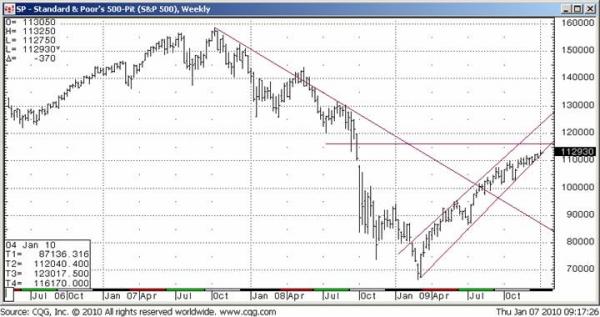
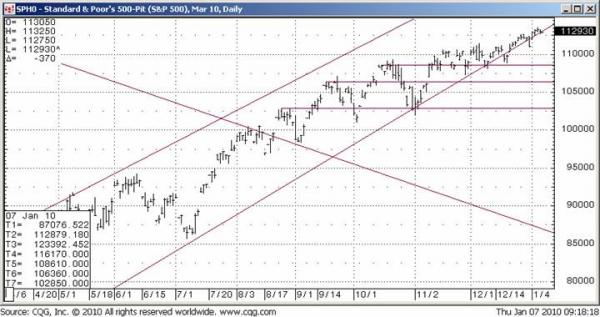
There are three reasons investors typically buy gold: as an inflation hedge, a safe-haven asset, and as a weak-dollar play. I call this rationale for gold bullishness “three-prong, why long.” Gold rallied nearly $40 in the first three days of the new year and closed above minor resistance at $1,133 an ounce. A close above $1,140 in February futures should power the market up to $1,185 or so.
In the next 12 months, I think gold should make new all-time highs. Some analysts predict the Federal Reserve won’t raise rates for the entire year. (They could, however, remove some of the quantitative easing.) If rates stay near zero, the carry trade is on. The U.S. dollar should remain weak and gold strong. The U.S. dollar had rallied in December 2009 on the idea that the economic reports were improving, and the Fed would have to take action. But some market participants think the economy might be too fragile to handle higher rates.
There is no denying gold has been in a bull market, you don’t have to be a genius to see that. If the Fed does raise its key short-term interest rate (Fed funds), that likely means they are afraid of inflation. As mentioned, inflation is another reason investors may flock to gold. The third prong of the gold argument is as a safe-haven asset. I don’t think we need the safe haven aspect right now, but we’ve got the potential for the other two prongs to keep gold’s bullish trend intact.
Gold Futures, Weekly
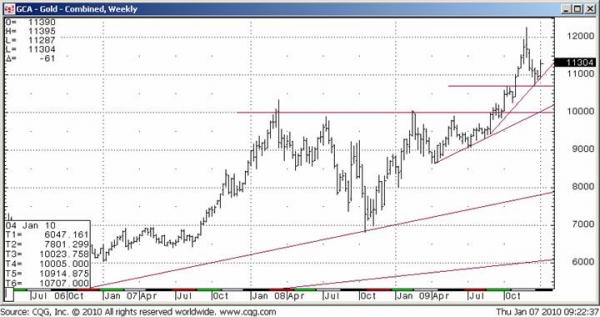
Crude oil has been on the upswing since March 2009, more than doubling in value by year-end 2009 to end the year up 77 percent. On January 7, 2010, crude oil futures traded at their highest level in almost 15 months, above $83 per barrel as the U.S. dollar weakened and frigid weather swept China and North America.
I’m bullish crude in general, but I think $87 should mark a near-term top for this latest push higher. I see a range of $68 – $87 likely this month. I feel a little more comfortable about the outlook for gold than crude oil. I think crude oil’s price might have gotten a little ahead of the fundamentals. Use tight stops when trading crude from the long side; I’m not sure how much farther the current rally can go.
However, if we run into supply issues, this market could really break out. On Wednesday, January 6, 2010, the Department of Energy’s weekly inventory report showed a gain in stockpiles of 1.3 million barrels, and even so, crude oil quickly rebounded. If a market doesn’t drop on bearish news, what happens when we get bullish news? This market could rocket higher. So, consider buying dips, but play the range in both directions.
If the global economy really picks up steam, energy consumption will increase. By February, watch for gasoline to get on people’s radar screens as we start thinking about the driving season.
Crude Oil Futures, Monthly
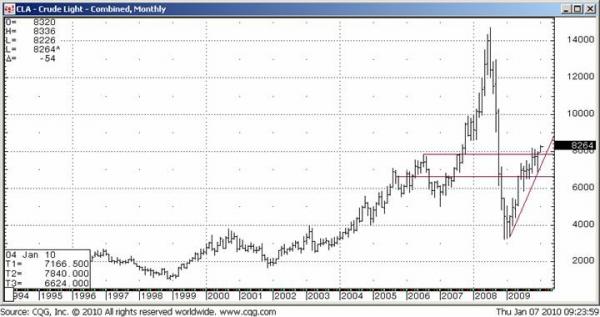
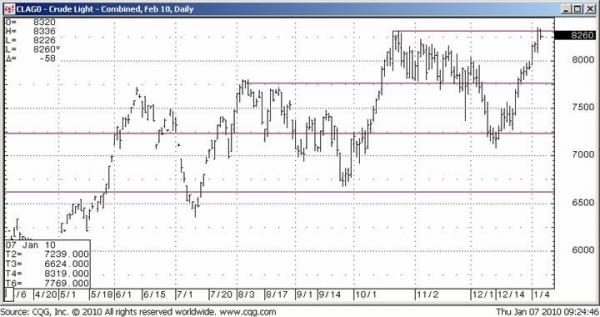
However, I think there is potential for a huge rally in this market, as colder weather draws down supplies for heating. In addition, natural gas is seen as a more environmentally friendly fuel than crude oil, and government efforts to encourage natural gas use should draw down supplies further. In the next two to three years, I can see more conversion to natural gas for our fuel needs. Even though this market has rallied quite a bit already, I think $5.2 MMMBtu in the NYMEX front-month futures represents a good area to consider buying for a long-term bullish outlook.
Natural Gas Futures,Weekly
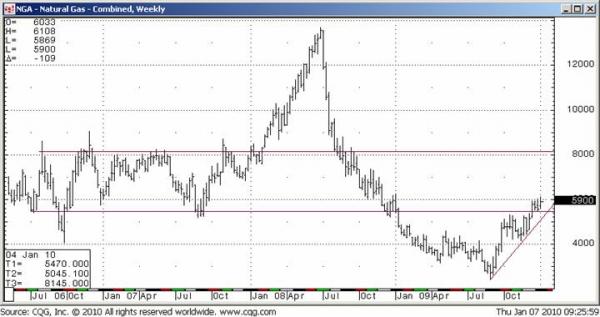
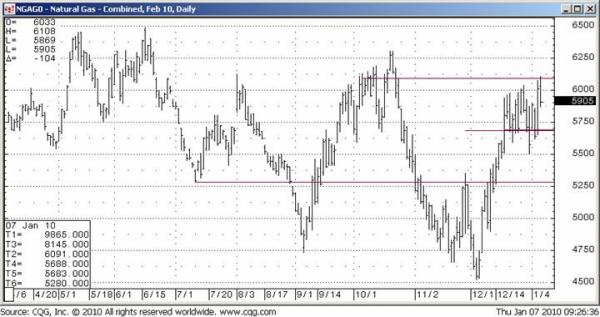
Futures trading involves substantial risk of loss and is not suitable for all investors. © 2010 MF Global Holdings Ltd. All Rights Reserved. Futures Brokers, Commodity Brokers and Online Futures Trading. 141 West Jackson Boulevard, Suite 1400-A, Chicago, IL 60604.



